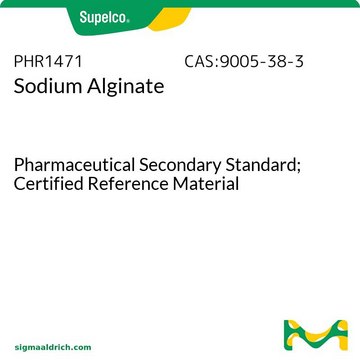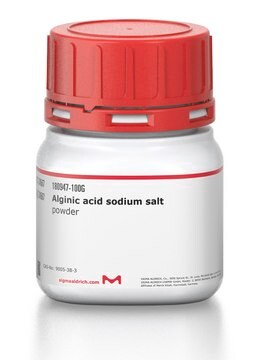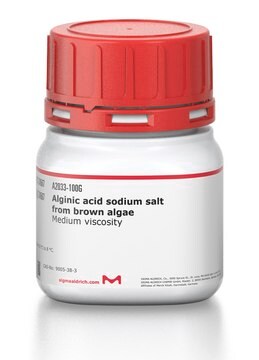918652
Low endotoxin alginate solution
Medium viscosity, 0.2 μm, sterile-filtered
Sinonimo/i:
Alginic acid, Sodium alginate
About This Item
Prodotti consigliati
Livello qualitativo
Sterilità
sterile-filtered
Forma fisica
viscous liquid
Concentrazione
1.75-3.50 wt. % in DPBS (buffer)
Impurezze
<10 EU/g Endotoxin
<5 CFU/g Bioburden (Fungal)
<5 CFU/g Bioburden (Total Aerobic)
Colore
colorless to pale yellow
Dimensione particelle
0.2 μm
pH
6.5-7.5
Temperatura di conservazione
2-8°C
Categorie correlate
Applicazioni
Alginate is an anionic polysaccharide that is widely used in pharmaceutical and biomedical applications due to its non-animal origin, low toxicity, biocompatibility, and biodegradability. Alginate hydrogels are commonly used to fabricate tissue engineering scaffolds, bioinks for 3D bioprinting, and nanocarriers for drug & gene delivery. Alginate is commonly crosslinked into a hydrogel via ionic-crosslinking with divalent cations (e.g., Ca2+).
Confezionamento
Codice della classe di stoccaggio
12 - Non Combustible Liquids
Classe di pericolosità dell'acqua (WGK)
WGK 2
Punto d’infiammabilità (°F)
Not applicable
Punto d’infiammabilità (°C)
Not applicable
Certificati d'analisi (COA)
Cerca il Certificati d'analisi (COA) digitando il numero di lotto/batch corrispondente. I numeri di lotto o di batch sono stampati sull'etichetta dei prodotti dopo la parola ‘Lotto’ o ‘Batch’.
Possiedi già questo prodotto?
I documenti relativi ai prodotti acquistati recentemente sono disponibili nell’Archivio dei documenti.
Il team dei nostri ricercatori vanta grande esperienza in tutte le aree della ricerca quali Life Science, scienza dei materiali, sintesi chimica, cromatografia, discipline analitiche, ecc..
Contatta l'Assistenza Tecnica.



